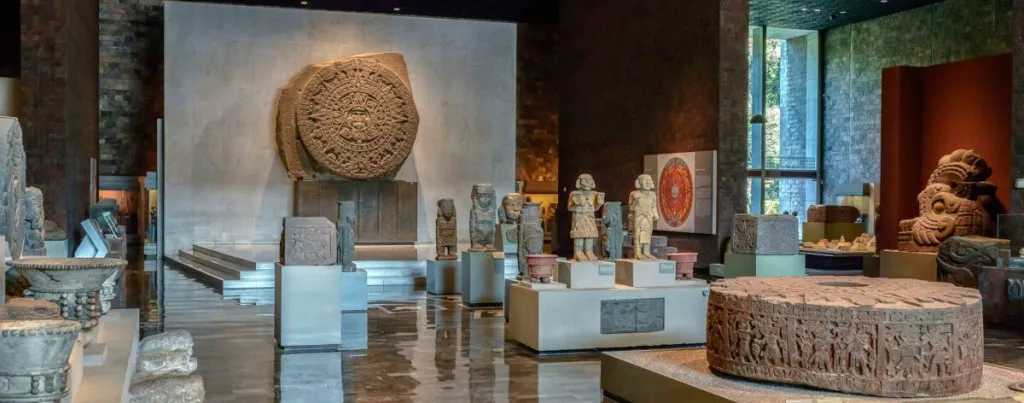The National Museum of Anthropology (Museo Nacional de Antropología) in Mexico City is a true gem nestled in the heart of the capital. More than just a museum, it serves as a gateway to the fascinating world of Mesoamerican civilizations, a place where Mexican history and culture are preserved and celebrated vibrantly. To prepare for your journey through this rich heritage, equip yourself with essential tips for a fulfilling and memorable experience.
Overview of the National Museum of Anthropology
Located within the expansive Chapultepec Forest, the National Museum of Anthropology stands as one of the largest and most comprehensive museums in Mexico. Boasting unique architecture and a vast collection, it’s an unmissable destination for anyone seeking a deep understanding of Mexican history, culture, and people. The museum’s design seamlessly blends open spaces with indoor exhibits, creating an engaging and captivating visitor experience.
Discovering the Main Exhibition Halls
The museum features 12 ground-floor exhibition halls, each dedicated to a specific pre-Hispanic civilization or geographic region of Mexico. The upper floor focuses on contemporary indigenous cultures of Mexico, showcasing the continuity between the past and present.
- Teotihuacán: Marvel at models and artifacts from Teotihuacán, one of Mesoamerica’s most powerful and influential cities.
- Los Toltecas: Admire one of the four basalt warrior columns from the Tula temple of Tlahuizcalpantecuhtli, symbols of the Toltec civilization’s strength and sophistication.

- Mexica (Aztec): Don’t miss the renowned Sun Stone, unearthed beneath the Zócalo, along with other exquisite sculptures from the Aztec temples.
- Oaxaca and the Gulf of Mexico: Explore the heritage of civilizations from Oaxaca and the Gulf of Mexico, including two colossal Olmec head carvings weighing nearly 20 tons.
- Maya: Behold a full-scale replica of King Pakal’s tomb, discovered deep within the Templo de las Inscripciones at Palenque.
Useful Visitor Tips
- Visiting Time: The museum is extensive, so allocate at least half a day, or even a full day, for a thorough visit.
- Guided Tours: Join a guided tour for deeper insights into the history and significance of the artifacts. Free tours in English are often available daily (except Sundays), but advance booking is recommended.
- Starting Point: Begin at the Introducción a la Antropología hall and explore counter-clockwise to gain a comprehensive overview of anthropology and the development of civilizations in Mexico.
- Resting: The museum offers a café and rest areas, so take breaks to relax and recharge.

Unveiling the History of Formation
The National Museum of Anthropology has a rich and complex history, reflecting Mexico’s profound interest in its cultural heritage. From collecting and preserving pre-Hispanic artifacts to establishing formal museum institutions, the museum has undergone significant stages of development.
In the late 18th century, documents from Lorenzo Boturini’s collection were sent to the Royal and Pontifical University of Mexico, marking a crucial step in cultural heritage preservation. In 1790, Mexico’s first Cabinet of Natural History was established, and the idea of an antiquities council to protect historical monuments began to take shape.
By the 19th century, Mexico attracted the attention of many renowned scientists, including Baron Alexander von Humboldt, who contributed to popularizing the artistic and historical value of pre-Hispanic monuments. In 1825, the National Museum of Mexico was founded by decree of President Guadalupe Victoria.

In 1940, the historical collections were moved to Chapultepec Castle, and the museum was officially renamed the National Museum of Anthropology. The current museum building was constructed from 1963 to 1964 under the direction of architect Pedro Ramírez Vázquez and inaugurated by President Adolfo López Mateos.
Activities Outside the Museum
Before entering the museum, you can witness the spectacular aerial dance ritual of the indigenous Totonac people. This ritual, performed atop a 20-meter-high pole, is an integral part of Totonac culture and a unique experience not to be missed.
Conclusion
The National Museum of Anthropology is more than just a repository of artifacts; it’s a vibrant space where past and present converge. With its extensive collection, impressive architecture, and unique cultural activities, the museum offers visitors profound insights into Mexican history and culture. Prepare thoroughly and dedicate time to explore all the fascinating aspects this museum offers. A visit to the National Museum of Anthropology is sure to be a memorable highlight of your journey through beautiful Mexico.